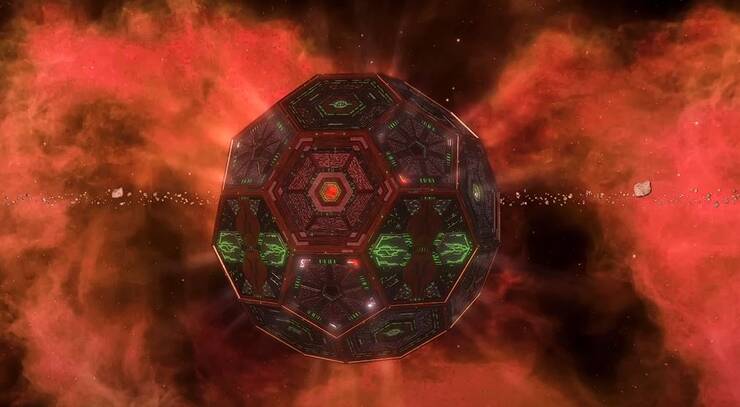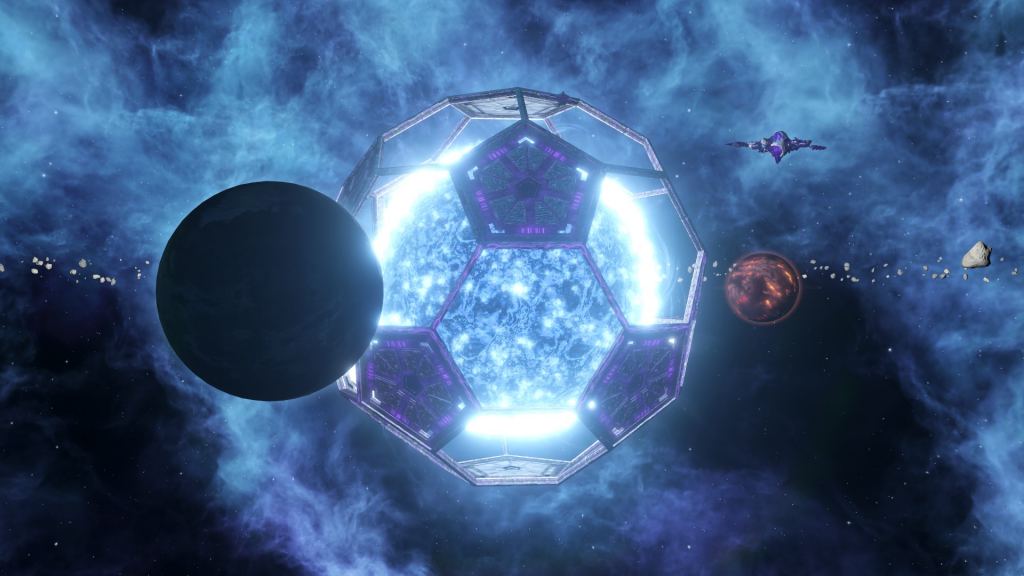Dyson Sphere is yet another multi-stage Stellaris Megastructure, based on the theoretical concept envisioned by physicist Freeman Dyson and added to the game in Utopia DLC. This megastructure encompasses a star thus turning everything in the star system where it’s located into frozen or cold barren worlds (cause you know, there’s no sun as it’s covered by the sphere). The Sphere has the sole purpose of harnessing the star’s power and turning it into energy. Once it’s completed, it severely increases your energy output. Take a look at the tech requirements and general tips and tricks on how you should use Stellaris Dyson Sphere.
Tech Requirements

Image credits: Paradox Interactive, Stellaris
As you might guess, if you want to build a monstrosity that encompasses the entire star and harness its energy transferring it to your empire, that kind of thing will have quite a few tech requirements. Actually, the requirements for Stellaris Dyson Sphere are exactly the same as the ones for the Ring World. In short, you need to get Galactic Wonders Ascension Perk which is only available after you researched Mega-Engineering tech and repaired or built one megastructure. So, go down the battleship engineering tech lane, get Mega-Engineering, restore or built another megastructure, and then take Galactic Wonders Perk. After that, you will be able to research Dyson Sphere technology.
Note that only by building or restoring a multi-stage megastructure will grant you Galactic Wonders. A great candidate for your first megastructure can be Mega-Shipyard as it’s very useful and fairly cheap to build.
Building Stellaris Dyson Sphere

Image credits: Paradox Interactive, Stellaris
Dyson Sphere is one of the most expensive megastructures in the game – the grand total price of a fully upgraded sphere stands at whooping 55 000 Alloys and 26 000 Unity. To make things even more difficult, it’s built through a total of 6 stages:
- Phase 1: Dyson Sphere Site (5000 Alloys, 1000 Unity); Effect: None
- Phase 2: Dyson Sphere Frame (10 000 Alloys, 5000 Unity); Effect: None
- Phase 3: Dyson Sphere Partial 25% (10 000 Alloys, 5000 Unity); Effect: + 1000 Energy
- Phase 4: Dyson Sphere Partial 50% (10 000 Alloys, 5000 Unity); Effect: + 2000 Energy
- Phase 5: Dyson Sphere Partial 75% (10 000 Alloys, 5000 Unity); Effect: + 3000 Energy
- Phase 6: Dyson Sphere Completed(10 000 Alloys, 5000 Unity); Effect: + 4000 Energy
As you can see, building the Dyson Sphere will be pricy and long – but, providing that you are not in a super-late phase of the game, you do need it. Amazing +4000 Energy credits that it provides once fully upgraded will allow you to build a larger fleet, sustain all the energy consumption your empire has, and more. The great thing about this enormous energy output is the fact that you can pretty much switch all your Technicians to other jobs since the Sphere will provide more than enough energy credits. Furthermore, that means that the initial cost in terms of Alloys is actually lower since you will be able to switch Technicians to Metallurgist jobs thus increasing the overall Alloy production.
Note that you can only build one Dyson Sphere but you can restore a ruined one as well meaning that potentially you can have two. It has to be built around a regular star (no pulsars, black holes, etc.).Dyson Sphere can’t be built in a star system where anomalies are present nor in binary or trinary systems.
A Real-Life Dyson Sphere

Image credits: Paradox Interactive, Stellaris
In case you are wondering how realistic Stellaris Dyson Sphere is – well, for humans, it’s still science fiction. What Freeman Dyson envisioned is something that perhaps a type 2 alien civilization is using. As we are still not even a type 1, according to Nikolai Kardashev’s civilization scale, obviously we can’t build anything remotely similar to a Dyson Sphere. However, not everything about this megastructure is science fiction – we can at least look for one. That’s what the scientists are doing now – observing the changes in light that come from distant stars, hoping to find an anomaly in terms of brightness, proving that a megastructure is what causes it. So far, scientists didn’t have much luck in finding one, except for one false alarm in 2015. The dims in brightness of the KIC 8462852 star turned out to be just dust circling around it so we are yet to discover the existence of Dyson Spheres.
Final thoughts on Stellaris Dyson Sphere Megastructure

Image credits: Paradox Interactive, Stellaris
As you can see, the Dyson Sphere megastructure comes with a great cost but also yields amazing energy output. The main disadvantage is not the cost though – it’s the tech requirements. Since the Sphere can’t be built as your first megastructure that means that you probably can’t rush-build it so it’s going to be finished in the late-game phase. For some empires, in this phase, energy output is not the problem, so if you are playing as one of those, then you should avoid building Dyson Sphere.
However, most of the empires do need a boost in energy credit output because of the fleet you need to deal with the End-Game Crisis. Furthermore, even if you have solid energy production, it’s still useful to replace Technicians with Metallurgists as you will probably need a lot of Alloys in the late stage of the game – and you can do that if you have a Dyson Sphere as you will no longer have a need for Technicians due to the energy output from the sphere.



